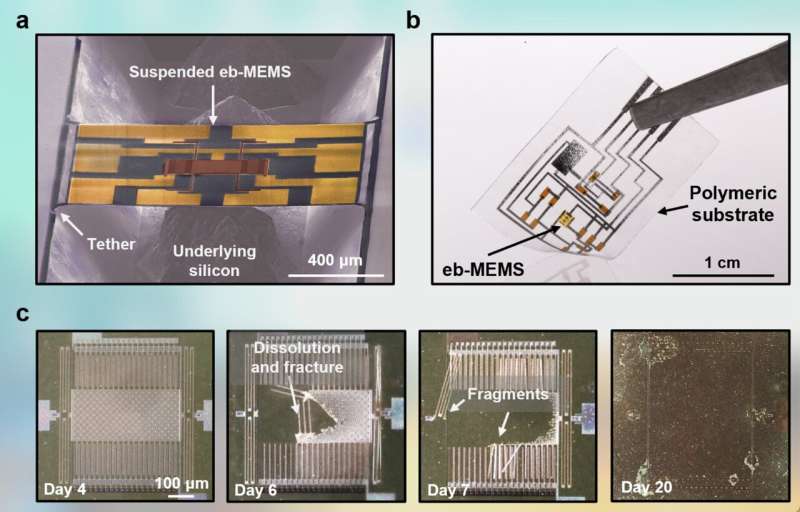Producing and testing ecoresorbable and bioresorbable MEMS. a, Suspended eb-MEMS with four tethers that connect the corners of the device to the source wafer during the production process. b, The integration of the eb-MEMS device with a flexible bioresorbable polymeric substrate and integrated circuits. Inset: an illustration of the integration of such devices onto the curved surface of the myocardium (that is, the muscle layer of the heart). c, The dissolution of an accelerometer, as a representative of eb-MEMS, at various stages. Credit: Yang et al.
Typically, the key goal of electronics engineers is to develop components and devices that are durable and can operate for long periods of time without being damaged. Such devices require resistant materials, which ultimately contribute to the accumulation of electronic waste on our planet.
Researchers at Northwestern University and the University of Illinois have been conducting research focusing on an entirely different type of electromechanical system (MEMS): those based on so-called "transient materials." Transient materials are materials that can dissolve, resorb, disintegrate or physically disappear in other ways at programmed and specific times.
Their most recent paper, published in Nature Electronics, introduces new MEMS based on fully water-soluble materials that could dissolve in their surrounding environment after set periods of time. In the future, these materials could help to decrease the amount of electronic waste, enabling the development of some electronic devices that spontaneously disappear when they are no longer needed.
"This work builds on our efforts in creating the materials and engineering foundations for 'transient' electronic devices," John A. Rogers, one of the researchers who carried out the study, told Tech Xplore. "A subset of this class of transient devices are those capable of resorption in biofluids or ground water through processes of hydrolysis, to benign end products."
Over the past few years, Rogers and his research group designed several materials that can dissolve in their surrounding environment. In their past work, they also demonstrated the huge potential of these materials for creating temporary medical implants with digital electronic capabilities.
For instance, they suggested the use of these materials to fabricate resorbable sensors that could be implanted in the brain of patients following a traumatic brain injury or after a brain surgery, to detect intercranial pressure. Similarly, they highlighted the potential use of bioresorbable materials for creating devices that stimulate the body from within, such as cardiac pacemakers (implanted devices that help patients to recover after a cardiac surgery by controlling their heart rhythm).
"Many of these systems could benefit from eco/bioresorbable MEMS technologies for advanced function, a capability that is absent from our past work in this area," Rogers explained. "Our new MEMS devices are uniquely characterized by their ability to dissolve in aqueous surroundings—either in the body or in the environment."
The MEMS created by this team of researchers are made up of different materials that gradually disappear, slowly reacting with water, and finally producing harmless and eco-friendly residues. These materials include doped polysilicon, silicon nitride and a bioresorbable polyanhydride-based polymer.
"We were the first to present examples of transient MEMS devices," Rogers said. "We envision applications spanning from temporary implants, to address current unmet needs in patient care, to environmental monitors that safely disappear after a period of use to avoid the need for recovery. Military applications could include sensitive systems deployed at a distance, where unwanted recovery by an adversary is a concern."
In initial tests and evaluations, Rogers and his team tested the ability of their materials to dissolve inside small animals while adhering to body tissues and attained highly promising results. Their work could thus eventually pave the way towards the fabrication of dissolvable medical implants, environmental sensors, and other types of devices that would benefit from disappearing in an eco-friendly way after completing specific tasks.
"In our current research, we are exploring the possibility of integrating these eco/bioresorbable MEMS into various of our resorbable electronics platforms to create new classes of temporary implant technologies," Rogers added.
More information: Quansan Yang et al, Ecoresorbable and bioresorbable microelectromechanical systems, Nature Electronics (2022). DOI: 10.1038/s41928-022-00791-1
Journal information: Nature Electronics
© 2022 Science X Network
























